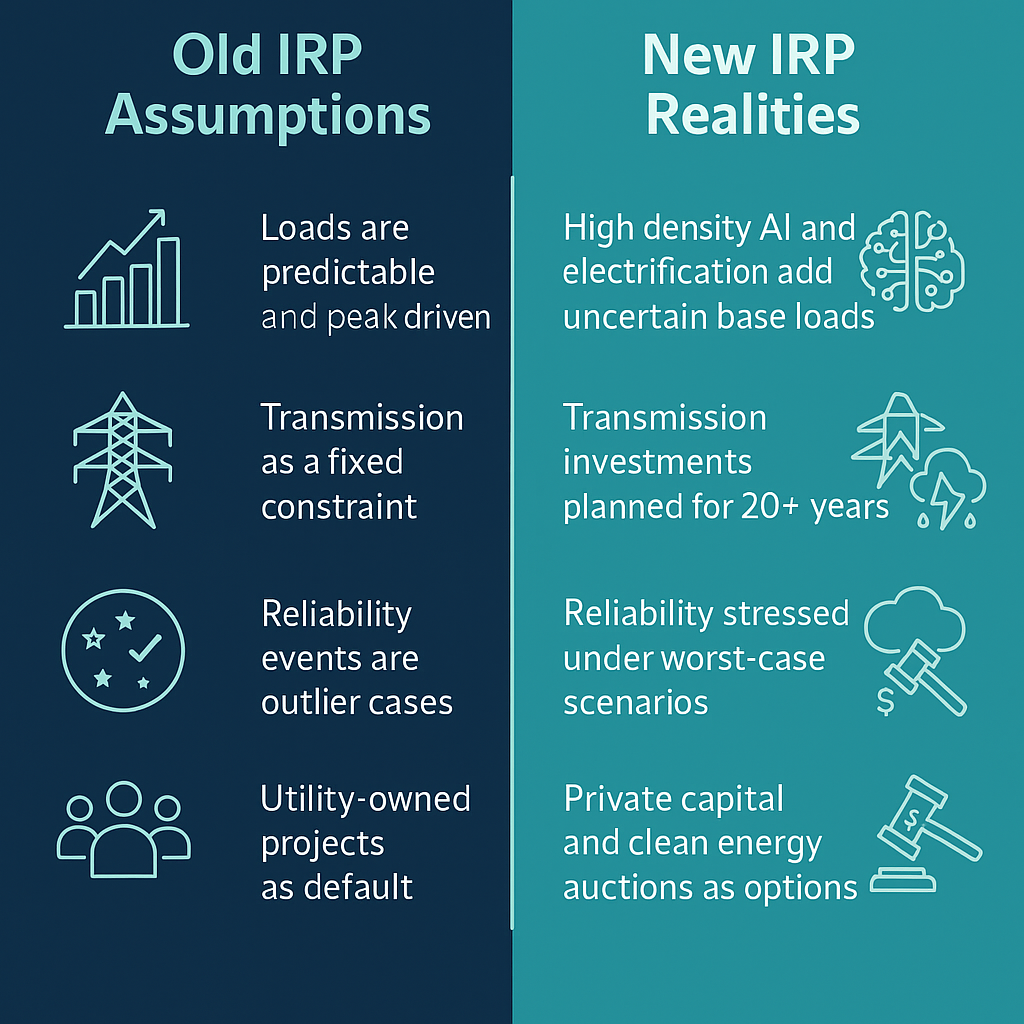.jpg)
The U.S. energy system is changing faster than most organizations’ planning cycles. New energy policies, evolving reliability requirements, rapid load growth from data centers, electrification, and a flood of distributed resources are reshaping what a “least cost, least risk” portfolio looks like.
Reliability expectations are being elevated in response to extreme weather and the growth of firm load requirements. In the U.S., the federal policy framework has shifted to energy density with fossil fuel and firm power requirements from the former policy of massive investment in renewables and EV's. State control remains a pathway for State Energy policy, and/or clean energy systems are perfect for private capital and competitive procurement.
A renewables-only strategy will not solve your integrated resource plans without engineering in reliability measures. As can be seen by the California Duck Curve, large swings of net load (grid demand minus renewables production) occur, where the middle of the day solar production leads to morning and end of day sharp ramps of net load.
.png)
We have found contagion of the California Duck Curve with so-called "Bird Curves" appearing in many jurisdictions globally. These "Bird Curves" yield the grid with low inertia on Sundays, when minimum load coincides with maximum solar production. This leads to large morning and evening ramps and can cause severe power swings from solar intermittency during the middle of the day. Smaller “baby bird curves” also appear at the distribution system level.
.png)
Mastering Integrated Resource Planning (IRP) is no longer optional. It is how utilities, regulators, and advisors make capital decisions that stand up to scrutiny, deliver reliability in extreme conditions, and keep bills affordable while meeting environmental commitments.
At its best, IRP turns policy shifts and technological complexity into a repeatable, defensible planning process. With the right methods, models, and software, utilities can translate goals into portfolios—and portfolios into procurement and execution.
For utilities, regulators, and energy project developers, the question is clear: How do you build Integrated Resource Plans (IRPs) that remain defensible, resilient, and actionable in this evolving landscape?
What’s Changing
New Load Patterns That Upend Planning
Hyperscale data centers, AI farms, and large-scale electrification push loads that are continuous, capacity-hungry, and unforgiving. These are not optional peaks but base loads with redundancy needs. IRPs must create dedicated, high density demand scenarios and capacity blocks to capture their distinct risk profile.

Transmission Planning Moves From Peripheral to Central
With FERC’s Order 1920, transmission providers are now required to engage in long term regional transmission planning over 20 year horizons and to develop multiple scenario pathways.
Earlier, many transmission expansions were reactive and incremental. Now they must be proactive, integrated into IRP design. Order 1920 also mandates clearer cost allocation and stronger state involvement.
This means IRP models must embed transmission deliverability, congestion risk, and scenario-driven buildouts, not simply treat transmission as a fixed constraint.
Reliability Under New Constraints
Reliability is no longer a checkbox. It is a portfolio performance metric. Planners must stress test under extreme weather, equipment derates, and temperature scenarios.
Changing Capital Models: Private Capital Plays a Bigger Role
Historically, resource planning in the U.S. leaned heavily on state-owned or regulated monopolies making the capital decisions. Today, private capital is playing a much larger role, reshaping how projects are financed, owned, and operated. While this trend is most visible in the United States, it influences IRPs everywhere: capital availability, risk appetite, and investor requirements increasingly shape which portfolios move forward.
This shift can be positive if paired with strong planning discipline. Private investment accelerates deployment, brings innovation, and diversifies risk. But it also raises questions: how do IRPs ensure that portfolios built with private capital still deliver on reliability, affordability, and public policy goals? That balance is the new frontier for planners, utilities, and regulators in the U.S.

What Still Matters But Must Be Elevated
These are the IRP fundamentals that must now be applied with greater rigor:
How Acelerex Supports Modern IRP
Here’s how we bring knowledge, technology, and strategic insight together:
1. Clear Objectives and Requirements
We begin by working with stakeholders to define planning objectives such as cost, emissions, resilience, and deliverability. We build requirement frameworks and system diagrams to anchor assumptions.
2. Integrated Modeling and Simulation
We co optimize capacity expansion and dispatch simulations, embedding constraints for inertia, transmission congestion, deliverability, and extreme events. Emerging technologies such as energy storage, DERs, and hybrids are represented with realistic ELCC, dispatch behavior, and cost trajectories.
3. Transmission and Scenario Embedding
We incorporate long term transmission planning pathways mandated by Order 1920 directly into IRP simulations, including alternative transmission technologies (dynamic line ratings, advanced switching) and scenario driven buildouts.
4. Reliability Stress Testing
Portfolios are tested not only under median conditions but under worst case stress: multi day heat waves, critical component outages, and prolonged fuel constraints. This is how reliability becomes a performance metric, not a formality.
5. Procurement Readiness
IRPs translate into executable strategies: procurement roadmaps, PPA templates, contract flexibility, and rolling update mechanisms. We ensure your planning results can plug smoothly into procurement and capital deployment.
IRP in a Mixed Public and Private Future
As private capital gains more influence, IRPs become both plans and signals. A well structured IRP helps regulators make defensible decisions and signals to investors that your utility is serious, credible, and prepared.
Closing Thoughts: Building IRPs That Thrive Under Change
Demand patterns are changing. Transmission must be proactive. Reliability must be stress tested. Capital models are evolving. IRP is the tool that navigates through all of this, turning uncertainty into portfolios you can defend and deploy.
At Acelerex, we bring deep modeling expertise, real world alignment with operations, and a forward looking perspective that helps utilities, regulators, and developers design IRPs built to last. Our work uncovering the “bird curves,” from the California Duck Curve to reliability patterns we have identified in markets worldwide, highlights how IRPs must anticipate both emerging risks and hidden system dynamics to stay resilient.
Aligned with this mission, Acelerex partnered with PGS Energy to host the Integrated Resource Planning seminar in Houston this December. This in depth two-day program will provide a deeper look at methods, models, and case studies for those who want to expand their understanding and sharpen their planning practices.
If you are ready to explore how IRP can be both defensible and actionable in today’s shifting landscape, we invite you to connect with us.
___
Sources and References:
Federal Energy Regulatory Commission (FERC) Order No. 1920: https://www.ferc.gov/news-events/news/ferc-strengthens-order-no-1920-expanded-state-provisions
A Look Ahead at Clean Energy in 2025**:** https://www.energy.gov/eere/look-ahead-clean-energy-2025
Integrated Resource Planning - Generation Transitions: Practical Realities: https://www.epri.com/research/products/000000003002030606